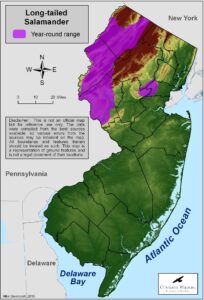Eurycea longicauda longicauda
Type: amphibian
Status: threatened
Species Guide
Long-tailed salamanader
Eurycea longicauda longicauda
Species Type: amphibian
Conservation Status: threatened
Identification
Although typically yellow, the ground color can range from yellowish orange to yellowish brown, with occasional reddish individuals. There are black spots on the back and sides. The underside is whitish to pale yellow. A key identifying feature is the row of irregular vertical black bars on the sides of the long, slender, keeled tail. The tail is disproportionately long, almost two-thirds of the animal’s total length. Adults measure 4.0 to 6.25” in length.

Distribution & Habitat
This species is found in limestone areas of northern New Jersey. Long-tailed salamanders inhabit slow moving streams, fens, and swamps. They may also live in abandoned mines or caves that are permeated by calcareous ground water.
Long-tailed salamanders prefer sites with loam soil types and upland deciduous forests. These typically contain calcareous fens, limestone outcrops, or caves. On the ground, rotting logs, stones, moss, and leaf litter provide shelter.Diet
Diet
These salamanders eat a variety of invertebrates. Their diet varies depending on habitat type, prey abundance, and preference. Spiders, beetles, and beetle larvae are consumed. In mines, spiders are often abundant and therefore constitute a large protion of the diet.
Life Cycle
In January and February, adults mate in subterranean tunnels near springs. The female secures her clutch of approximately 90 eggs to stones or boards underwater. From February to early March, the eggs hatch and the larval salamanders seek cover near the seepage. If the surface dries, the salamanders may trek through crevices in search of underground water.
They remain in the larval stage for three to five months. Some individuals undergo an additional year of development, transforming 14 to 15 months after hatching. Metamorphosis occurs during May and June. Following metamorphosis, the juvenile salamanders seek cover under bark, logs, and rocks near seepages.
Throughout the summer months, long-tailed salamanders remain near water. They regularly move between underground crevices and feeding areas on the surface. By late September and October, they retreat from pond margins and migrate to wintering sites within caves, mines, or the surrounding forest.
Current Threats, Status, and Conservation
Habitat loss and water-quality degradation are the primary threats facing long-tailed salamander populations in New Jersey. Unchecked development leads to direct habitat destruction as well as secondary impacts such as sedimentation of freshwater ponds. Removal of trees near breeding ponds eliminates the shade favored by this species and results in siltation of ponds. Actions that alter the hydrology, such as filling ponds or blocking springs jeopardize breeding habitats. In addition, draw-downs of the water table may alter spring flow and, in turn, adversely affect long tailed salamanders. Groundwater contamination resulting from multiple sources grades the streams and ponds needed for larval development.
Both the aquatic and terrestrial habitats occupied by long-tailed salamanders should be protected from development and degradation. Watersheds should be safeguarded from changes in hydrology that may alter or reduce spring flow. In addition, breeding ponds should be monitored to ensure high water quality.
Currently, surveys are conducted to monitor known sites and locate additional populations. This enables biologists to document changes in the range of this species throughout the state. The Freshwater Wetlands Protection Act and environmental reviews of proposed development afford protection to long-tailed salamander habitats in New Jersey.
References
Text derived from the book, Endangered and Threatened Wildlife of New Jersey. 2003. Originally written by Sherry Liguori. Edited and updated by Brian Henderson.
Scientific Classification
- Kingdom: Animalia
- Phylum: Chordata
- Class: Amphibia
- Order: Caudata
- Family: Plethodontidae
- Genus: Eurycea
- Species: E. longicauda longicauda